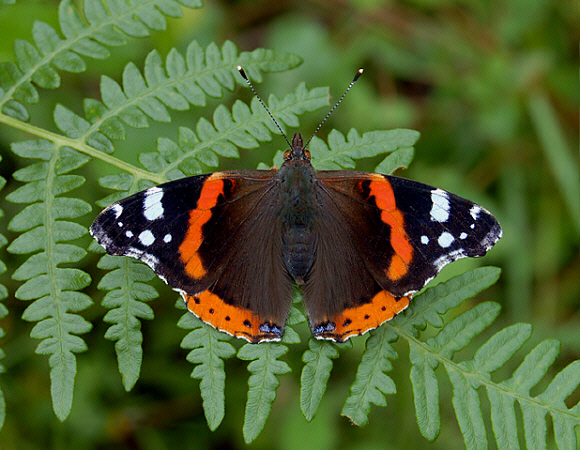
Introduction
The Red Admiral is probably Britain’s most well known butterfly, and certainly one of the most beautiful, with it’s almost perfect pattern of red bands and white spots on a black background. It was first named as “the Admirable” by Moses Harris in 1766.
The butterfly is widely distributed and common throughout mainland Europe and north Africa. In northern Scandinavia it is a regular migrant. In Britain its status has changed over the years. Up to the end of the 19th century it was considered to be a resident that hibernated as an adult butterfly.
During the 20th century it occurred as a migrant, although there were occasional years when a few adults managed to survive the winter at sites along the south coast of England. Recently there has been a further change in status. The butterfly can now be seen flying regularly on sunny days even in mid winter in the southern counties of Hampshire, Dorset and Sussex. There is now evidence also that larvae resulting from eggs laid in late autumn can successfully overwinter and produce a new generation of adults in early spring.
The Red Admiral cannot be confused with any other European butterfly except the similar Indian Red Admiral Vanessa indica, which has a much wider, irregularly shaped red band on the forewings. It occurs together with atalanta on Madeira and the Canary Islands, and throughout much of the Oriental region, but is inexplicably absent from Europe and north Africa.
Elsewhere in the world there are several other Red Admiral species, including buana from Sulawesi, samani from Sumatra, dejeani from Bali, and the very beautiful gonerilla from New Zealand.
Habitats
This Red Admiral occurs in Britain as a migrant originating from north Africa and southern Europe, and being a highly mobile species, it can turn up in any habitat including woodlands, grasslands, meadows, heathlands and moors, coastal habitats, riverbanks, low montane habitats, gardens, parks, allotments and town centres. Males also gather at certain grassland hilltop sites, apparently to intercept migrating females.
The number of migrants varies according to climatic conditions in Europe, and in turn this greatly affects the number of UK bred butterflies seen later in the year.
Migrants arriving in the early spring oviposit on stinging nettles growing alongside hedgerows or in woodland glades, producing a summer brood in the UK which typically emerges from mid July to early August. In early autumn these butterflies migrate south, arriving in southern woodlands where they congregate to nectar at ivy blossom.
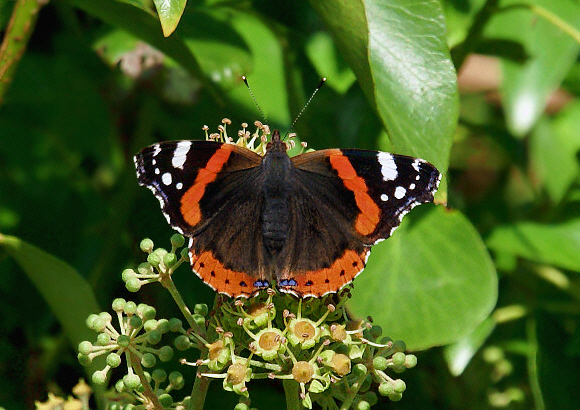
There is now mounting evidence that in mild winters a small percentage of Red Admirals are able to successfully over-winter in southern England. They awake on warm days, and sightings are frequent in southern woodlands on sunny days between October and late January.
In harsh winters Red Admirals are usually killed by the hard February frosts, but since the turn of the 21st century the species has successfully overwintered in significant numbers in many parts of southern England. In the winter of 2006/2007 for example there were almost unbroken sightings in West Sussex, Hampshire and Dorset from October until the following March. The surviving adults laid eggs as early as January, producing a new generation of adults which emerged in early May.
|
Red Admiral sightings in Stansted Forest, winter 2006-2007 |
||||||||||||||||||||||||||||||||
|
|
Sept |
Oct |
Nov |
Dec |
Jan |
Feb |
Mar |
Apr |
||||||||||||||||||||||||
|
40 |
||||||||||||||||||||||||||||||||
|
35 |
||||||||||||||||||||||||||||||||
|
30 |
||||||||||||||||||||||||||||||||
|
25 |
||||||||||||||||||||||||||||||||
|
20 |
||||||||||||||||||||||||||||||||
|
15 |
||||||||||||||||||||||||||||||||
|
10 |
||||||||||||||||||||||||||||||||
|
5 |
||||||||||||||||||||||||||||||||
|
1 |
||||||||||||||||||||||||||||||||
The chart above depicts the build up of Red Admirals following southward migrations into Stansted Forest, 4 miles from the English south coast on the Hampshire / West Sussex border; and the rapid reduction in the population following the gales, frosts and snow of late January & early February. In early March most of the surviving Red Admirals dispersed into the surrounding countryside. Their progeny emerged in May, coinciding with the arrival of a new wave of immigrants from Europe.
On 9th November 2007, I counted a minimum of 12 Red Admirals in a small section of Stansted Forest, but estimated that at least 150 must have been present in the whole wood.
Unfortunately, extremely wet and windy conditions prevailed over the following few weeks, decimating the population. On 23rd December however, I watched 2 Red Admirals basking on tree-trunks in the forest, despite having endured 6 consecutive nights of severe ( minus 3-C ) frost the previous week. At the end of January, in mild sunny conditions at least 3 Red Admirals were flying in the forest, but cold and wet conditions persisted throughout the spring, killing off the last survivors, and none were seen at Stansted after 9th February.
|
Red Admiral sightings in Stansted Forest, winter 2007-2008 |
||||||||||||||||||||||||||||||||
|
|
Sept |
Oct |
Nov |
Dec |
Jan |
Feb |
Mar |
Apr |
||||||||||||||||||||||||
|
40 |
||||||||||||||||||||||||||||||||
|
35 |
||||||||||||||||||||||||||||||||
|
30 |
||||||||||||||||||||||||||||||||
|
25 |
||||||||||||||||||||||||||||||||
|
20 |
||||||||||||||||||||||||||||||||
|
15 |
||||||||||||||||||||||||||||||||
|
10 |
||||||||||||||||||||||||||||||||
|
5 |
||||||||||||||||||||||||||||||||
|
1 |
||||||||||||||||||||||||||||||||
Compared to the previous winter, 2007-2008 was cooler, windier and considerably wetter, with fewer sunny days. Frosts were minimal prior to March, which produced many icy nights. April began very cold, with snow, sleet and hail. The harsh winter conditions had no negative impact on other hibernating butterflies, with Peacock, Comma, Brimstone and Small Tortoiseshell all being recorded in average numbers in mid-late April.
The low number of Red Admirals arriving in autumn 2007 was mainly attributable to lower breeding success and reduced immigration during the exceptionally cool and wet summer. The maximum count was on 21st October when 17 were recorded nectaring at ivy flowers.
Winter survival rates were very low, with only one sighting in March, and no more until 2 immaculate and extremely active individuals were seen on 25th May. Their condition and behaviour strongly suggested they had emerged locally within the previous couple of days – providing fairly conclusive evidence that they were the progeny of post-hibernation adults that had successfully over-wintered at Stansted Forest.
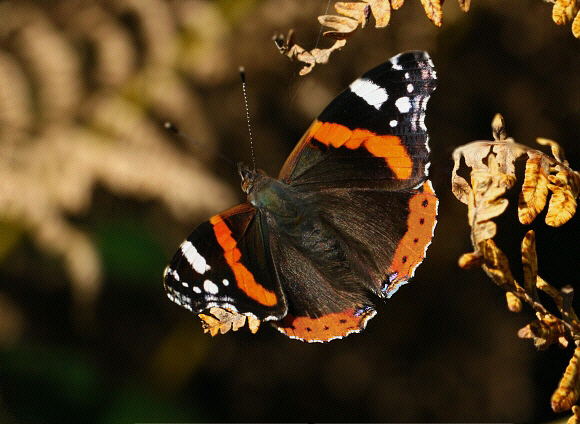
Lifecycle
In late April and early May, female Red Admirals can be observed flying around nettle patches in woodland glades. They periodically alight on nettle leaves Urtica dioica, upon which they lay a single egg. Usually a dozen or so eggs will be laid on any sizeable nettle patch. Egg-laying is interspersed with periods of basking and nectaring – typically at blackthorn, crab apple, and wild cherry.
Second brood adults, which may be of either UK or European origin, are less fussy about oviposition sites. They will lay their eggs in any sheltered sunny lowland habitat where the foodplant grows e.g. in July 2008 I watched 2 Red Admirals laying eggs on the same small clump of unkempt nettles in my garden. Each laid about a dozen eggs between about 11.00am and 1.00pm.
The eggs were all laid singly on the upperside of terminal nettle leaves. The egg-laying bouts, which each lasted about 2-3 minutes were interspersed with periods of basking, and periodic flights to nectar at a Buddleia bush a few metres away. Interestingly a Comma was ovipositing simultaneously on the same nettle patch, and neither species seemed disturbed by the presence of the other.
The larva lives within a tent of folded nettle leaves, spun together with silk. Every few days, as the leaf-tent gets devoured, the larva moves house, and spins a new tent nearby. If the tent is opened, the spiky greenish-brown larva can be seen within, normally curled in a J shape, head-downwards.
The larvae of most butterfly species tend to wander away from their foodplants to pupate, but the Red Admiral is unusual, forming it’s greyish chrysalis within the final leaf-tent.
Adult behaviour
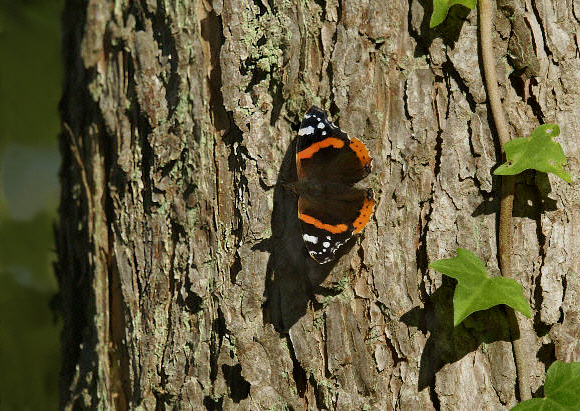
On sunny days the butterflies often bask on tree-trunks, always assuming a head-downwards or sideways facing position. In warm but overcast weather they like to bask on the foliage of bramble, hazel and other bushes.
In early spring Red Admirals nectar at sallow catkins and the blossom of blackthorn and hawthorn.
Favoured summer nectar sources include dogwood, hemp agrimony, bramble, marjoram, devil’s bit scabious, ragwort, burdock, spear thistle and ivy blossom. They also visit dung, or imbibe mineral salts from damp ground, and attend sap runs on oak trunks. In gardens they will nectar at Buddleia, ice-plant and michaelmas daisies. In orchards they will feed at fallen apples or pears.
Habituation: Red Admirals are one of the more intelligent butterfly species – they have the ability to habituate, i.e. to learn to react less strongly to stimuli that prove to be harmless. Upon entering their territory an intruder is immediately investigated. In the case of human intruders a Red Admiral will circle around several times, and will try to ascertain whether the person poses a threat. If he or she appears to be harmless the butterfly gets progressively braver – e.g. I have on many occasions been dive-bombed by individuals that have swooped to make contact with the top of my head. Once the butterfly has become habituated to the human presence, the dive-bombing ceases, and the butterfly behaves as if there was no one present. On the other hand, if an intruder reacts to the butterfly by chasing it, it becomes wary, and further chasing will be enough to drive the butterfly out of the vicinity for several minutes, even if there are attractants such as good nectar sources available. |
Males are highly territorial, chasing after Commas and Peacocks as well as other Red Admirals. When nectaring however they will accept the presence of other species, and I have often seen mixed groups of Red Admirals, Silver-washed Fritillaries, Commas, and Large Whites gathered on a single flower head of hemp agrimony or Buddleia.
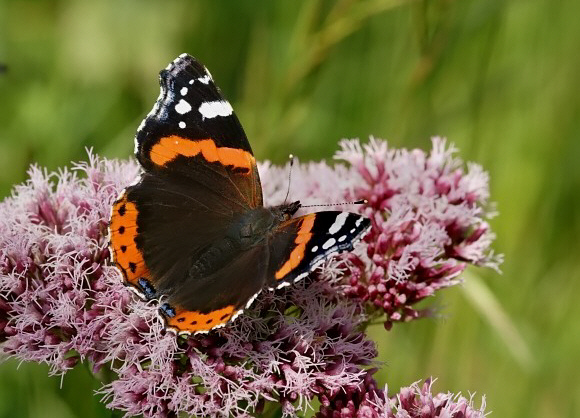
At night, on cold overcast days, and during the winter months, Red Admirals roost head-downwards on the trunks or lower branches of oaks, larches and other trees, where the bark-like underside of the wings provides them with excellent camouflage.

